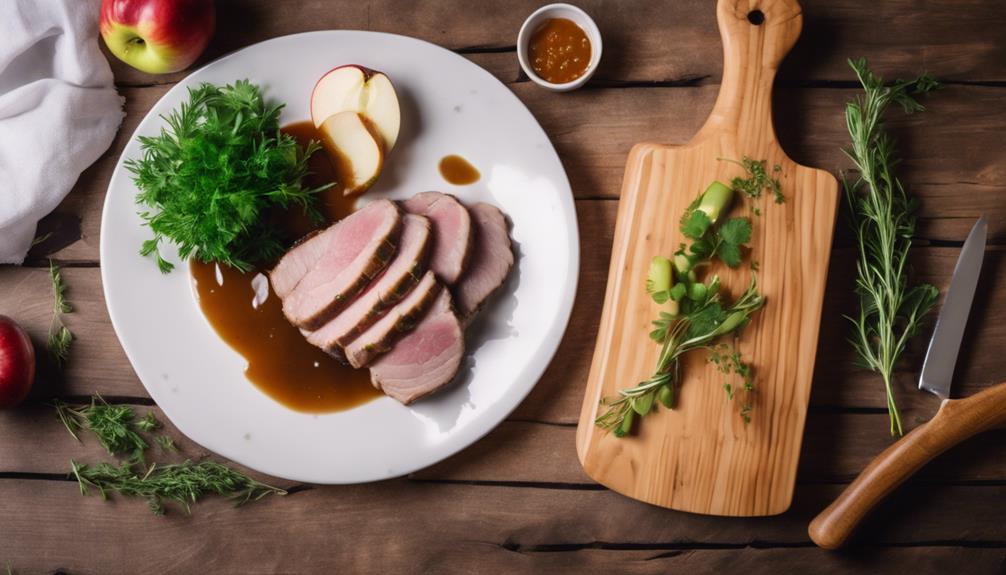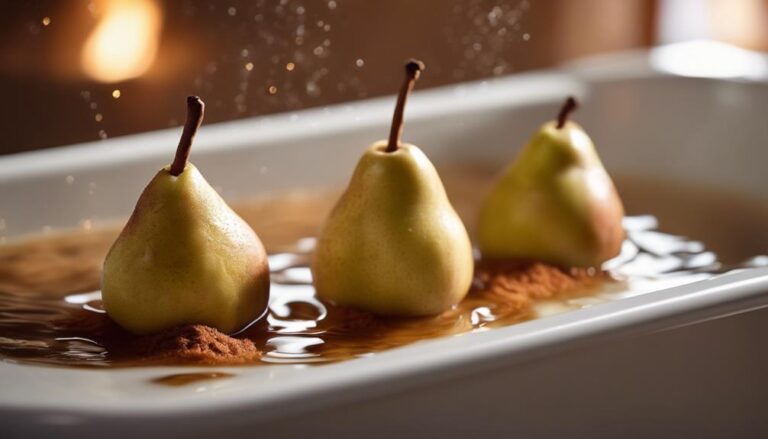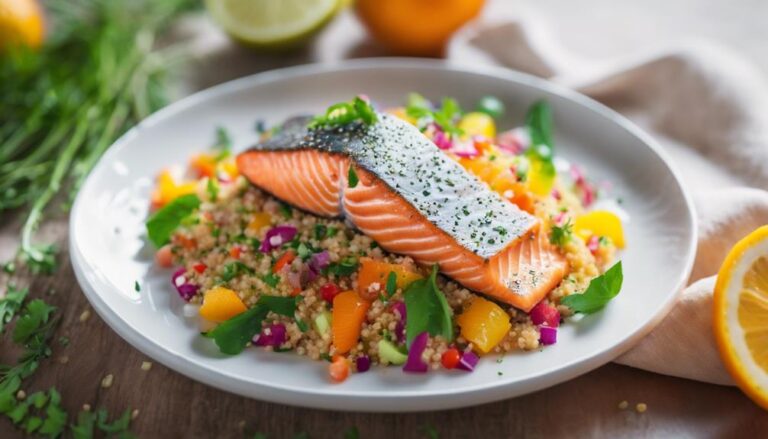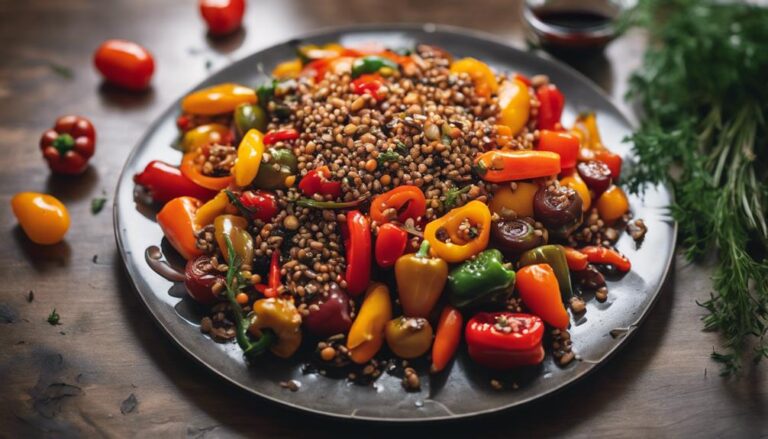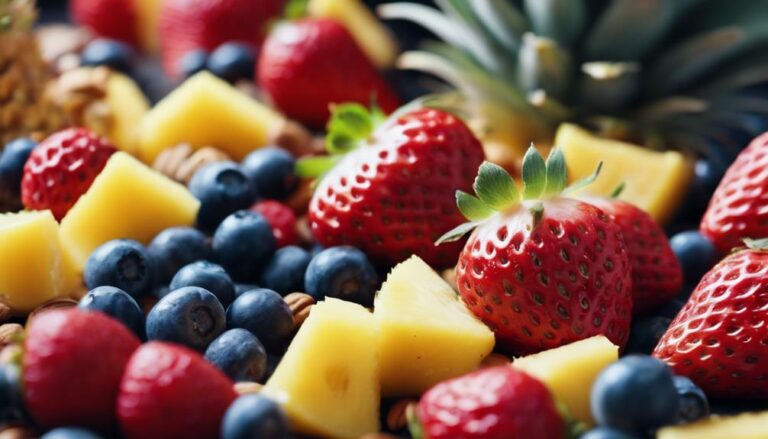Sous Vide Pork Tenderloin With Apple Sauce
To achieve a succulent pork tenderloin with apple sauce using sous vide: Season pork, vacuum-seal with apple slices, and sous vide at 140°F for 2 hours. Sear pork in a hot skillet for a caramelized crust. Make apple sauce by simmering apples with sugar, cinnamon, and cider until soft. Blend for a smooth consistency. Serve sliced pork with apple sauce drizzle for a flavorful balance. This method guarantees tender, juicy pork with a hint of sweetness in every bite. Master the art of sous vide pork tenderloin with apple sauce for a restaurant-quality dish at home.
What You Will Learn Here
- Sous vide pork tenderloin ensures juicy, flavorful results.
- Apple sauce adds rich, sweet contrast to the dish.
- Searing after sous vide enhances flavor through Maillard reaction.
- Precision cooking guarantees tender perfection.
- Pairing pork with apple sauce showcases culinary creativity.
Culinary Evolution of Sous Vide
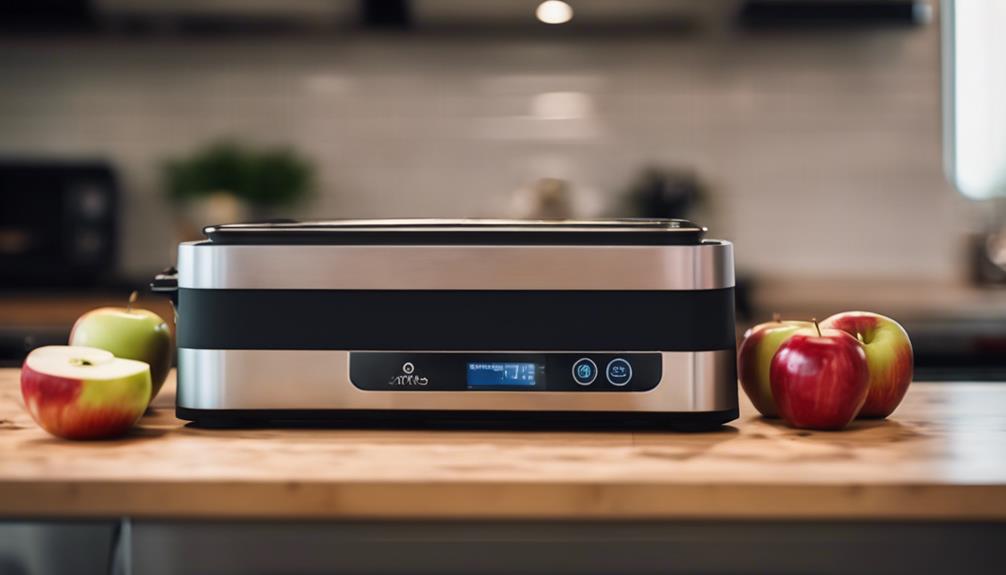
Sous vide has a fascinating history that dates back to the late 1960s. Its benefits include precise temperature control and enhanced flavors.
Modern chefs have developed innovative techniques to elevate sous vide cooking to new heights.
History of Sous Vide
Exploring the evolution of sous vide in culinary history reveals a fascinating journey of innovation and precision cooking techniques. Sous vide has its origins in French culinary techniques, dating back to the late 18th century, where chefs used vacuum-sealed bags to cook ingredients at precise temperatures in water baths. Over time, sous vide gained popularity for its ability to maintain the natural flavors and textures of foods while ensuring consistent results.
Historically, sous vide found applications in various chef innovations, particularly in the 1960s and 1970s when French and American chefs experimented with this method to enhance the quality of their dishes. Notable chefs like Georges Pralus and Bruno Goussault played significant roles in refining sous vide techniques and promoting its use in professional kitchens worldwide.
As chefs continued to explore the possibilities of sous vide, its techniques evolved, leading to the widespread adoption of this cooking method in both restaurant and home kitchens. The historical journey of sous vide showcases how innovation and precision have shaped modern culinary practices.
Sous Vide Benefits
The evolution of sous vide techniques has revolutionized culinary practices, offering a multitude of benefits that enhance the quality and consistency of dishes. One of the key sous vide advantages is cooking precision. By precisely controlling the temperature during the cooking process, sous vide guarantees that food is cooked evenly from edge to edge. This precise control also allows for ideal retention of flavors, juices, and nutrients within the ingredients, resulting in exceptionally flavorful and tender dishes.
Moreover, sous vide cooking offers the convenience of time management. You can prepare your ingredients, vacuum-seal them, and place them in the water bath to cook slowly while you attend to other tasks. This method reduces the risk of overcooking, as the food can't surpass the set temperature, providing a safety net for busy cooks.
In addition to these benefits, sous vide cooking is known for enhancing the natural colors and textures of ingredients, presenting beautifully plated dishes that are sure to impress both visually and in taste.
Modern Sous Vide Techniques
Modern culinary trends have propelled sous vide techniques into a new domain of precision and creativity. Precision cooking is at the heart of modern sous vide methods, where temperature control is key to achieving consistent results. By vacuum-sealing ingredients in bags and immersing them in a precisely heated water bath, chefs can guarantee that food cooks evenly without losing moisture or flavor.
Temperature control is a fundamental aspect of sous vide cooking, allowing for precise adjustments that cater to different ingredients and desired levels of doneness. This level of accuracy has revolutionized the way chefs approach cooking, giving them the ability to experiment with textures and flavors in ways that were previously unimaginable.
Pantry Staples
What essential ingredients should you always have on hand in your pantry for preparing delicious sous vide dishes like pork tenderloin with apple sauce? Here are four must-have pantry staples for your sous vide adventures:
- Herbs and Spices: Keep a variety of dried herbs and spices like rosemary, thyme, cumin, and paprika to enhance the flavors of your sous vide creations. Experiment with different combinations to add depth to your dishes.
- Oils and Vinegars: Stock up on olive oil, vegetable oil, and vinegars such as balsamic and apple cider vinegar. These ingredients are essential for marinating meats before sous vide cooking and adding finishing touches to your dishes.
- Broths and Stocks: Having chicken, beef, or vegetable broths on hand can elevate the taste of your sous vide dishes. Use them as a base for sauces or to infuse extra flavor into your proteins.
- Sweeteners and Condiments: Sugar, honey, soy sauce, and mustard are versatile ingredients that can be used to balance flavors and create delicious glazes for your sous vide creations. Having these pantry staples readily available will help you whip up tasty dishes with ease.
Tasty Sous Vide Creations

When it comes to tasty sous vide creations, you have a range of options to explore.
Succulent pork loin sous vide, apple cider glazed pork, and savory pork belly sous vide are just a few mouthwatering dishes you can enjoy.
Whether you're a seasoned sous vide enthusiast or just starting out, these flavorful recipes are sure to impress your taste buds.
Succulent Pork Loin Sous Vide
For succulent pork loin sous vide that bursts with flavor, start by selecting a high-quality cut of meat. Follow these steps to guarantee a juicy texture and peak flavor infusion:
- Quality Cut: Begin with a fresh pork loin, preferably with a good marbling of fat for enhanced tenderness.
- Seasoning: Rub the pork loin with a blend of your favorite herbs and spices to elevate its taste profile.
- Vacuum Seal: Place the seasoned pork loin in a vacuum-sealed bag to lock in moisture and flavors during the sous vide process.
- Precise Cooking: Set your sous vide machine to the recommended temperature and cooking time for pork loin to achieve a perfectly cooked, succulent result.
Apple Cider Glazed Pork
Indulge in the delectable flavors of apple cider glazed pork with this tantalizing sous vide creation. This dish combines the richness of pork with the sweetness of apple cider, resulting in a mouthwatering experience that will leave you craving more. Slow cooking the pork in a sous vide bath guarantees that every bite is tender, juicy, and full of flavor. Whether you're a seasoned chef or just starting out, this recipe is sure to impress your taste buds and your dinner guests.
Markdown List:
- Enhanced Flavors: The apple cider glaze adds a unique sweetness to the pork, elevating the dish to a whole new level of deliciousness.
- Tender Texture: By using the sous vide method, the pork becomes incredibly tender and juicy, making each bite a true delight.
- Versatile Dish: This apple cider glazed pork is a versatile dish that can be served on its own, with sides, or even in sandwiches for a tasty meal any time of day.
- Perfect for Pork Lovers: If you enjoy pork recipes, this apple cider glazed pork is a must-try for its incredible taste and simplicity in preparation.
Savory Pork Belly Sous Vide
If you're looking to expand your sous vide repertoire beyond apple cider glazed pork, consider trying out a savory Pork Belly Sous Vide recipe for a flavorful twist on this cooking method. Pork belly indulgence awaits with this indulgent dish that promises savory delights in every bite.
Here are some reasons to explore into sous vide experimentation, flavor fusion with this delectable pork belly recipe:
- Tender Perfection: Sous vide cooking guarantees that the pork belly is cooked to a precise temperature, resulting in a tender and juicy final product.
- Enhanced Flavors: By marinating the pork belly before sous vide cooking, you can infuse it with a variety of herbs and spices, creating a symphony of flavors.
- Crispy Finish: After the sous vide process, a quick sear in a hot pan can give the pork belly a delightful crispy exterior while maintaining its succulent interior.
- Versatile Pairings: The rich flavors of pork belly make it a versatile ingredient that can be paired with a range of sides, from creamy mashed potatoes to vibrant salads.
Searing Sous Vide Pork Tenderloin
When searing sous vide pork tenderloin, you enhance its flavor profile through the Maillard reaction, creating a beautifully caramelized crust.
To achieve this, consider various techniques such as using high heat, butter-basting, or finishing on a grill for added depth of flavor and texture.
Searing is essential in elevating the taste of your tenderloin, so explore these methods to take your dish to the next level.
Searing for Flavor
Start by heating a skillet over high heat to achieve a significant sear on your sous vide pork tenderloin. Searing is an important step that not only enhances the taste but also provides a visually appealing caramelized crust on the outside of the meat. This process locks in the juices, ensuring a succulent and tender texture when you slice into the pork tenderloin.
As the skillet gets hot, add a small amount of oil to prevent the pork from sticking. Once the skillet is properly heated, carefully place the sous vide pork tenderloin in the pan. Allow it to sear undisturbed for a few minutes on each side to develop a beautiful golden-brown color and a rich flavor profile.
The flavorful searing creates a contrast between the crispy exterior and the moist, tender interior of the pork tenderloin, resulting in a delightful sensory experience with each bite. This step adds depth to the overall dish, elevating the sous vide pork tenderloin with apple sauce to a new level of culinary excellence.
Maillard Reaction Importance
Enhance the flavor and texture of your sous vide pork tenderloin by understanding the importance of the Maillard reaction during searing.
The Maillard reaction is a chemical reaction between amino acids and reducing sugars that gives browned food its distinctive flavor.
When you sear your sous vide pork tenderloin after cooking it in the water bath, you trigger the Maillard reaction, which leads to the development of complex and delicious flavors on the surface of the meat.
This reaction not only enhances the taste of the pork but also contributes to the appealing brown color and crispy texture that you desire in a perfectly cooked tenderloin.
Crust Development Techniques
To achieve a perfect crust on your sous vide pork tenderloin, consider employing various searing techniques that enhance both flavor and texture. After cooking your pork tenderloin in a sous vide water bath, the final step of achieving a delicious crust is important.
One popular method is pan-searing the pork tenderloin. Heat a skillet over high heat, add oil, and sear the pork for a few minutes on each side until a golden-brown crust develops.
Another technique is torch-searing, which involves using a culinary torch to quickly caramelize the surface of the pork, creating a crispy outer layer.
Additionally, you can try grilling the pork tenderloin for a smoky flavor and distinctive grill marks.
Whichever method you choose, make sure your pork is dry before searing to promote better crust development. Experiment with these sous vide techniques to find the perfect crust that complements the tender, juicy pork tenderloin.
Final Thoughts
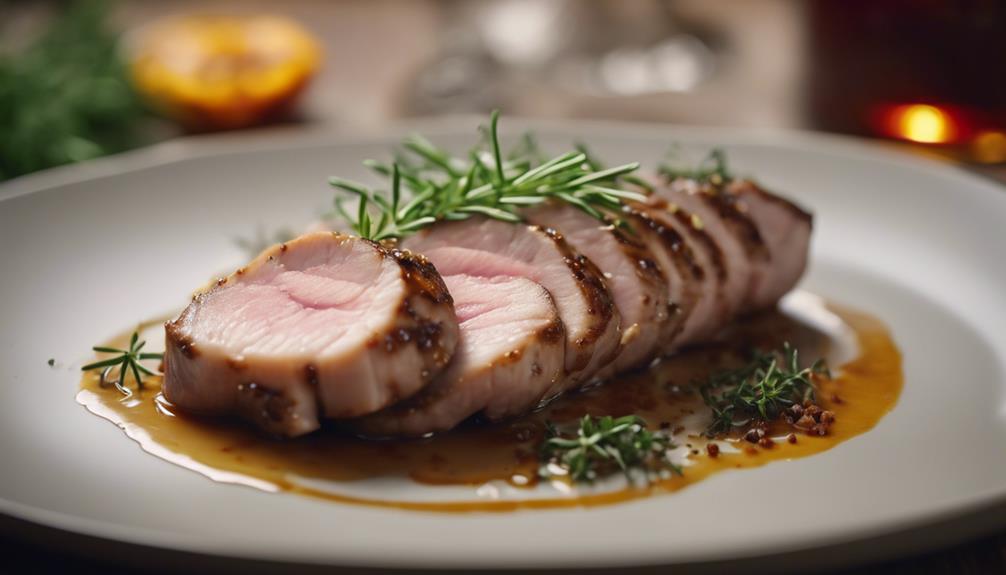
Reflecting on all the steps you've taken to create this delicious Sous Vide Pork Tenderloin with Apple Sauce, it becomes clear that your dedication has paid off in a flavorful and tender dish. By embracing culinary trends such as sous vide cooking methods, you've elevated this classic pork dish to a whole new level of perfection.
The use of sous vide, a popular cooking technique in modern kitchens, allowed you to precisely control the temperature, ensuring that the pork tenderloin was cooked evenly from edge to edge. This method helped the meat retain its natural juiciness and enhanced its tenderness, resulting in a melt-in-your-mouth experience that's hard to achieve with traditional cooking methods.
Pairing the succulent pork with a tangy apple sauce not only added a delightful contrast of flavors but also showcased your creativity in combining different elements to create a harmonious dish. The final result is a culinary masterpiece that not only satisfies the taste buds but also reflects your skill and passion for cooking. Cheers to a job well done!
Frequently Asked Questions
Can I Use a Regular Pot Instead of a Sous Vide Machine?
You can create a stovetop alternative for slow cooking by DIY'ing a makeshift sous vide setup. Achieve temperature control by using a regular pot filled with water and a thermometer. Maintain consistent heat for a successful dish.
How Long Can I Store Sous Vide Pork Tenderloin in the Fridge?
You can store pork tenderloin in the refrigerator for up to 3-4 days. Follow food safety guidelines for storing leftovers to guarantee freshness and prevent spoilage. Place it in an airtight container to maintain quality.
Is It Necessary to Use a Vacuum Sealer for Sous Vide Cooking?
For sous vide cooking, a vacuum sealer isn't necessary. Zip-lock bags or water displacement method are good vacuum sealer alternatives. Benefits of sous vide include precise temperature control, even cooking, and enhanced flavors. Enjoy experimenting!
Can I Sous Vide Pork Tenderloin Without Any Seasonings?
Yes, you can sous vide plain pork tenderloin without any seasonings. However, to enhance flavor, consider using alternative seasonings like garlic, herbs, or citrus zest. Experiment to find what suits your taste preferences best.
What Other Fruits Can Be Used to Make a Sauce for Pork Tenderloin?
You can use grilled peaches or mango salsa for a fruity twist on your pork tenderloin. If you prefer a tangy option, cranberry compote or a citrus glaze can also add delicious flavors to your dish.
Conclusion
Sous vide pork tenderloin with apple sauce is a delicious and tender dish that can be easily prepared at home. By using the sous vide method, you can achieve perfectly cooked pork every time.
The addition of apple sauce adds a sweet and tangy flavor that complements the pork beautifully. Searing the pork after cooking adds a nice crust and additional depth of flavor.
Give this recipe a try for a gourmet meal that will impress your family and friends.
